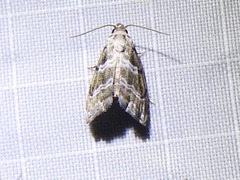
Abablemma is a genus of moths in the family Erebidae. The genus was described by Nye in 1910.
Xoria is a monotypic moth genus of the family Erebidae erected by Ian W. B. Nye in 1975. Its only species, Xoria filifera, was first described by Francis Walker in 1869. It is found in the Congo Basin.
Quandara is a monotypic moth genus of the family Noctuidae described by Nye in 1975. Its only species, Quandara hypozonata, was first described by George Hampson in 1910. It is found in Panama.
Beriohansa is a monotypic moth genus of the family Noctuidae described by Nye in 1975. Its only species, Beriohansa hansali, was first described by Felder in 1874. It is found in Ethiopia.
Cadiorapa is a genus of moths of the family Noctuidae. The genus was described by Nye in 1975.
Catalana is a genus of moths of the family Noctuidae. The genus was erected by Pierre Viette in 1954.
Yidalpta is a genus of moths of the family Erebidae. The genus was erected by Ian W. B. Nye in 1975.
Ipanephis is a monotypic moth genus of the family Noctuidae described by Nye in 1975. Its only species, Ipanephis esperanzalis, was first described by Schaus in 1913. It is found in Costa Rica.
Despumosia is a monotypic moth genus of the family Noctuidae described by Nye in 1975. Its only species, Despumosia rubescens, was first described by Paul Köhler in 1952. It is found in Argentina's Chubut Province.
Habershonia is a monotypic moth genus of the family Erebidae described by Nye in 1975. Its only species, Habershonia areos, was first described by Pieter Cramer in 1777. It is found in the Virgin Islands.
Hapda is a monotypic moth genus of the family Erebidae described by Nye in 1975. It was first described by Francis Walker in 1863 as Dapha. Its only species, Hapda exhibens, was described by Walker in 1863.
Hulypegis is a monotypic moth genus of the family Erebidae described by Nye in 1975. Its only species, Hulypegis procopialis, was first described by Jacob Hübner in 1825. It is found in Suriname.
Mopothila is a monotypic moth genus of the family Erebidae described by Nye in 1975. Its only species, Mopothila ardalus, was first described by Herbert Druce in 1891. It is found in Panama.
Naboa is a genus of moths of the family Erebidae. The genus was described by Nye in 1975.
Radosa is a genus of moths of the family Erebidae. The genus was described by Nye in 1975.
Ramopia is a genus of moths of the family Erebidae. The genus was described by Nye in 1975.
Siccyna is a genus of moths of the family Erebidae. The genus was described by Nye in 1975.
Tabomeeres is a monotypic moth genus of the family Noctuidae described by Nye in 1975. Its only species, Tabomeeres dolera, was first described by Turner in 1939. It is found in Australia.
Tadaxa is a genus of moths of the family Erebidae. It was described by Nye in 1975.
Tesomonoda is a monotypic moth genus of the family Noctuidae described by Nye in 1975. Its only species, Tesomonoda endolopha, was first described by George Hampson in 1910. It is found in New Guinea.
